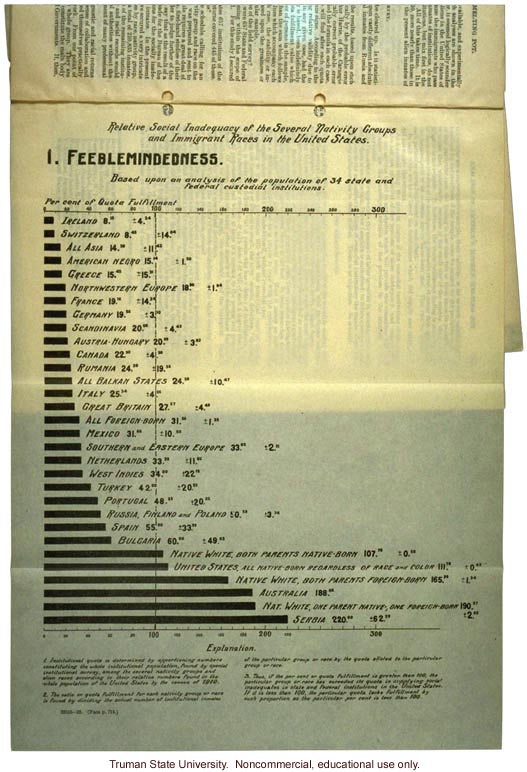Relative Social Inadequacy of the Several Nativity Groups and Immigrant Races in the United States.
[chart]
I. Feeblemindedness.
Based upon an analysis of the population of 34 State and Federal custodial institutions.
Percent of Quota Fulfillment
0&20&40&60&80&100&120&140&160&180&200&220&240&260&280&300
[black bar]Ireland 8.15 [plus or minus sign]4.24
[black bar]Switzerland 8.45 [plus or minus sign]14.04
[black bar]All Asia 14.50 [plus or minus sign]11.42
[black bar]American Negro 15.04 [plus or minus sign]1.50
[black bar]Greece 15.45 [plus or minus sign] 15.31
[black bar]Northwestern Europe 18.98 [plus or minus sign] 1.94
[black bar]France 19.16 [plus or minus sign]14.24
[black bar]Germany 19.34 [plus or minus sign]3.10
[black bar]Scandinavia 20.00 [plus or minus sign] 4.42
[black bar]Austria-Hungary 20.99 [plus or minus sign] 3.82
[black bar]Canada 22.50 [plus or minus sign] 4.50
[black bar]Rumania 24.28 [plus or minus sign] 19.56
[black bar]All Balkan States 24.58 [plus or minus sign]19.34
[black bar]Italy 25.34 [plus or minus sign]4.26
[black bar]Great Britain 27.27 [plus or minus sign]4.48
[black bar]All Foreign-Born 31.54 [plus or minus sign]1.25
[black bar]Mexico 31.66 [plus or minus sign]10.50
[black bar]Southern and Eastern Europe 33.02 [plus or minus sign]2.25
[black bar]Netherlands 33.32 [plus or minus sign]11.86
[black bar]West Indies 34.00 [plus or minus sign]22.18
[black bar]Turkey 42.02 [plus or minus sign]20.32
[black bar]Portugal 48.23 [plus or minus sign]20.25
[black bar]Russia, Finland and Poland 50.53 [plus or minus sign]3.74
[black bar]Spain 55.00 [plus or minus sign]33.99
[black bar]Bulgaria 60.00 [plus or minus sign]49.02
[black bar]Native White, Both Parents Native-Born 107.70 [plus or minus sign]0.50
[black bar]United States, All Native-Born regardless of Race and Color 111.78 [plus or minus sign]0.02
[black bar]Native White, Both Parents Foreign-Born 165.29 [plus or minus sign]1.34
[black bar]Australia 188.88
[black bar]Nat. White, One Parent Native-, One Foreign-Born 190.27 [plus or minus sign]2.05
[black bar]Serbia 220.00 [plus or minus sign]62.29
[hatched line]
0&20&40&60&80&100&120&140&160&180&200&220&&300
[end chart]
Explanation.
1. Institutional quota is determined by apportioning numbers constituting the whole institutional population, found by special institutional survey, among the several nativity groups and alien races according to their relative numbers found in the whole population of the United States by the census of 1910.
2. The ratio or quota fulfillment for each nativity group or race is found by dividing the actual number of institutional inmates of the particular group or race by the quota allotted to the particular group or race.
3. Thus, if the percent or quota fulfillment is greater than 100, the particular group or race has exceeded the quota in supplying social inadequates in state and Federal institutions in the United States. If it is less than 100, the particular quota lacks fulfillment by such proportion as the particular per cent is less than 100.
33555-23. (Face p. 731.)


